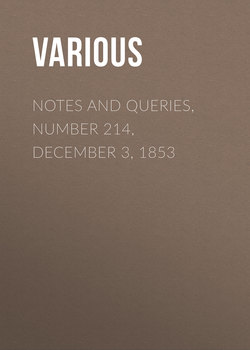Читать книгу Notes and Queries, Number 214, December 3, 1853 - Various - Страница 6
Minor Notes
ОглавлениеChair Moving.—Recent occurrences made me look back at Glanvill's Blow at Modern Sadducism, and I observed that in his account of the "Dæmon of Tedworth," who was supposed to haunt the house of Mr. Mompesson, and who was the original of Addison's "drummer," it is stated that on the 5th November, 1662, "in the sight and presence of the company, the chairs walked about the room," p. 124.
N. B.
Epitaph on Politian in the Church of the Annunciation at Florence.—
"Politianus in hoc tumulo jacet Angelus, unum
Qui caput, et linguas (res nova) tres habuit."
—From Travels of Sir John Reresby.
Y. B. N. J.
[The following translation of this epitaph is given in the Ency. Britannica, but it is there stated to be in St. Mark's, Florence:
"Here lies Politian, who, things strange indeed,
Had, when alive, three tongues, and but one head."]
Epitaph in Torrington Churchyard, Devon.—
"She was—my words are wanting to say what.
Think what a woman should be—she was that."
Which provoked the following reply:
"A woman should be both a wife and mother,
But Jenny Jones was neither one nor t'other."
Balliolensis.
The early Delights of Philadelphia.—In Gabriel Thomas's Description of the Settlement of Philadelphia occurs the following passage:
"In the said city are several good schools of learning for youth, for the attainment of arts and sciences, also reading and writing. Here is to be had, on any day in the week, cakes, tarts, and pies; we have also several cook-shops, both roasting and boiling, as in the city of London: happy blessings, for which we owe the highest gratitude to our plentiful Provider, the great Creator of heaven and earth."
Is not this a superb jumble?
A Leguleian.
Misapplication of Terms.—Legend is a thing "to be read" (legendum), but it is often improperly applied to traditions and oral communications. Of this there have been some instances in "N. & Q." One has just turned up, Vol. v., p. 196.: "I send you these legends as I have heard them from the lips of my nurse, a native of the parish."
J. W. Thomas.
Dewsbury.
"Plantin" Bibles in 1600.—While looking over the "Stackhouse Library" (see "N. & Q.," Vol. viii., p. 327.), I observed on the fly-leaf of an Hebrew Bible, 1600 (A. 100 in catalogue), a short MS. memorandum, which I think worth preserving. It ran as follows:
R. C. Warde.
Kidderminster.
Ancient Gold Collar found in Staffordshire.—It may probably interest some of your readers to know that a very ancient golden collar was lately found in the village of Stanton, Staffordshire, which is about three miles north of Ashbourne.
A labourer digging up a field, which had not been ploughed or dug up in the memory of man, turned up the collar, which, being curled up at the time, sprang up, and the labourer taking it for a snake, struck it out of his way with his spade: the next morning it was discovered not to be a snake. Unfortunately the blow had broken off a small piece at one end. The collar is now in the possession of the person with whom the curate of Stanton lodges. The description given to me is, that it is about two feet long, and formed of three pieces of gold twined together, and, with the above exception, in a very good state of preservation.
I hear that there is a similar collar in the British Museum, that was found in Ireland, but none that was found in England; and that the authorities of the Museum have been informed of this collar, but have taken no steps to obtain possession of it.
S. G. C.
[Our correspondent is under an erroneous impression as to gold torques not being found in England. Several are figured in the Archæologia, and we have some reason to believe that the torque now described, and of which we should be glad to receive any farther particulars, resembles one which formed part of the celebrated Polden find described by Mr. Harford in the fourteenth volume of the Archæologia, and figured at p. 90.; and also that found at Boyton in Suffolk in 1835, and engraved in the Archæologia, vol. xxvi. p. 471.—Ed.]
